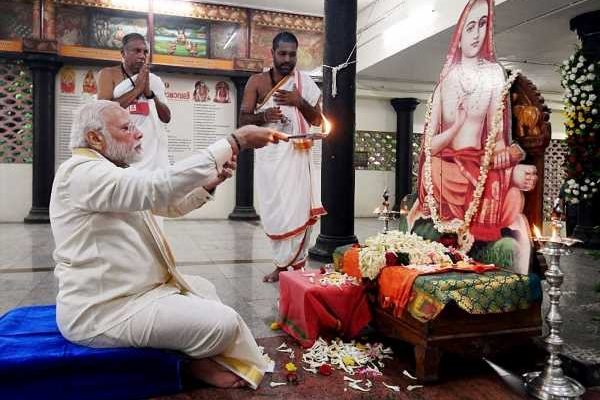On Easter, April 9, 10,000 BJP workers are being assigned to visit the houses of 100,000 Christian families.
Plans are afoot to visit the homes of Muslims on Eid.
A Hallelujah Chorus, followed by an invocation by a Baptist Church pastor, is most likely to fasten on a Christian event.
However, this was the swearing-in of Neiphiu Rio, who is in alliance with the Bharatiya Janata Party, as Nagaland chief minister on March 8.
More importantly, this was in the presence of Prime Minister Narendra D Modi, Union Home Minister Amit A Shah, BJP President J P Nadda, and Assam CM Himanta Biswa Sarma.
According to political experts and party functionaries, this is the model the BJP wants to replicate down south in Kerala, taking the minorities along with it.
In the North East, critics even dubbed the party ‘Bharatiya Jesus Party’.
The Nagaland ceremony came days after Modi told workers at the party headquarters in New Delhi that the BJP would continue to expand and Kerala would be the next staging post.
Later a question came to the public mind how the party would do this in a state that has traditionally voted for either the Left Democratic Front (LDF), led by the Communist Party of India (Marxist), or CPI-M, or the United Democratic Front (UDF), led by the Congress.
More importantly, even after several attempts and also the Sabarimala issue, which allegedly turned Hindus in the state against the LDF government, the BJP hardly managed to translate these into votes.
Although the BJP’s vote share increased from a mere 6.1 per cent in 2011 to 15.3 per cent in the assembly elections in 2016, it slipped to 14 per cent in 2021, despite the party being at the forefront of the Sabarimala protests.
It even lost the only seat of Nemom it had won in 2016, backed by the persona of veteran leader O Rajagopal.
The saving grace in the elections of 2021 was that it came second in at least eight constituencies, when the party had expected at least 20 per cent vote.
The ambitious target set by Modi needs to be seen taking this into account.
Strategy to grab more votes
“In Kerala in the age group 60 and above, the majority of the people are committed to Communist politics. Similarly, for those in the age group 50-70, there are people loyal to the Congress. It is those below 40 years, or the youth, that the BJP is primarily targeting,” a senior BJP leader B Gopalakrishnan told Business Standard.
According to him, surveys say 31-36 per cent of the state’s population admire Modi and of that, around 70 per cent are below 40.
“It will be through job creation and reaching out by focusing on central schemes like Startup India and those in micro, small, and medium enterprises,” he added.
According to the 2011 Census, 54.7 per cent of the state’s population are Hindu, 26.6 per cent Muslim, and 18.4 per cent Christian.
Hence, the party is looking at grabbing “30-40 per cent of the votes from the Hindu community”.
According to the official data, around 21 per cent of Kerala’s population are the Ezhavas, while the Nairs account for 12 per cent.
An alliance with the Bharat Dharma Jana Sena (BDJS), with blessings from the leadership of the Sree Sree Narayana Dharma Paripalana Yogam (a body of Ezhavas), is considered one step towards getting a good share of this Hindu vote bank.
The Ezhavas are considered to be a traditional vote bank of the CPI-M.
On the other hand, it has already started outreach programmes among Christian communities.
“During the Christmas week in 2022, thousands of BJP workers visited the homes of Christian families across the state, giving them gifts and distributing Christmas cards with the picture of Modi on it,” said a senior church leader based out of Kochi, while stating that no official talks happened with his community in this regard.
On Easter, April 9, 10,000 BJP workers are being assigned to visit the houses of 100,000 Christian families.
Plans are afoot to visit the homes of Muslims on Eid.
Similarly, these Christian families are being invited to BJP workers’ homes on Vishu (April 15).
“The idea is to build bonds with Christian communities and to reduce the misconception spread by the CPI-M and the Congress that the BJP is against minorities. Targeting those below 40 years through central government schemes will help us overcome other political parties in 10 years. It is not a concept to win Kerala in 2026. It is a long-term plan for 10-15 years,” said Gopalakrishnan.
However, it may not be an easy ride for the party.
“We have to see that almost 99 per cent of the BJP votes are coming from the majority community. Even among the majority community, they are not able to penetrate. Unless it changes its ideological stand of majoritarianism, coming to power may be difficult in Kerala. They may also have to form a strong third front because the state’s politics is bipolar,” said J Prabhash, a political analyst and former Kerala University pro vice-chancellor.
The lack of a strong regional ally like in Nagaland and other states was one reason why it was unable to make its mark in Kerala, Prabhash added.
Though the strategy is ready, there are experts who say it may need some out-of-the-box ideas for the party to increase its vote share.
They are raising the possibility of Modi contesting from Thiruvananthapuram.
“Then the entire equation will change and the party will get a fair chance to perform well in places like Attingal, Palakkad, and Thrissur, and increase its chances in all its seats. It may also help them in getting 15 or more seats in the next assembly elections too,” added Prabhash.
Source: Read Full Article

